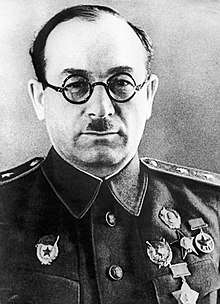Pavel Rotmistrov
Chief marshal of the armored troops Pavel Alexeyevich Rotmistrov (Russian: Павел Алексеевич Ротмистров; 6 July 1901 in Skovorovo – 6 April 1982) was a Soviet military commander of armoured troops in the Red Army during and following World War II, known for leading the 5th Guards Tank Army at the Battle of Prokhorovka.
Pavel Rotmistrov | |
|---|---|
 | |
| Born | 6 July 1901 Skovorovo, Russian Empire |
| Died | 6 April 1982 (aged 80) Moscow, Soviet Union |
| Allegiance | Soviet Union |
| Years of service | 1919–1968 |
| Rank | Chief marshal of the armored troops |
| Commands held | 3rd Guards Tank Corps 5th Guards Tank Army |
| Battles/wars | Operation Uranus Battle of Kursk Battle of Prokhorovka Operation Polkovodets Rumyantsev Battle of the Lower Dnepr Operation Bagration |
| Awards | Hero of the Soviet Union |
| Other work | Deputy Commander of the mechanized forces of the Group of Soviet Forces in Germany Assistant Minister of Defense of the Soviet Union |
Pre-War
Rotmistrov joined the Red Army in 1919, and served during the Russian Civil War, during which he was involved in the suppression of the Kronstadt Rebellion and in the Polish Soviet War. He commanded a platoon and later rifle company in 31st Rifle Regiment of 11th Rifle Division. In 1928 he entered Frunze Military Academy. From 1937 to 1940 he was an instructor at the Moscow Higher Military Academy. In May 1941 he became Chief of Staff of the 3rd Mechanised Corps.
Second World War
He commanded 5th Guards Tank Army in the Battle of Prokhorovka during the Battle of Kursk, and in Operation Bagration. The unit under his command, the 5th Guards Tank Army engaged in a brutal tank battle near Prokhorovka against the attacking Waffen SS divisions Leibstandarte SS Adolf Hitler, Das Reich and Totenkopf almost in a point-blank range of 100-200 meters. As the German advance was noticed, spearheaded by the three most elite Waffen SS divisions towards Prokhorovka advancing in force, Rotmistrov ordered direct counter-attack from the army that was prepared to go by radioing "Steel, Steel, Steel" against the Germans to get close to them as possible to make up for the better guns the German tanks had. In the ensuing battle, a close-quarter open field tank battle ensued so that most shots from both sides were a direct hit. The distance between the forces was such that tanks were shooting each other from left and right one after another and close enough to ram the German tanks to disable their relatively powerful guns from turning.
As the battle ended, significant losses were reported from the 5th Guards Tank Army. He was removed from command following Bagration and became deputy head of armored troops at the General Staff. The manner in which he conducted the battle including the heavy losses the 5th Guards Tank Army took was not unnoticed by Joseph Stalin that he planned to have Rotimstrov court-martialed and sacked for the heavy losses. This did not occur since Aleksandr Vasilevsky interceded. It is possible that the high losses incurred by the 5th Guards Tank Army at the Battle of Minsk led to his removal from command. It is notable that he never held an active unit command again. He was promoted to colonel-general in October 1943 and became the first Marshal of Armoured Troops in February 1944.
Post-War
Following the war he commanded the mechanized forces of the Group of Soviet Forces in Germany, and he became an assistant minister of defense. He became the first Chief Marshal of Armoured Troops on 28 April 1962.
External links
- (in English) Biography on Generals.dk
- (in Russian) Biography